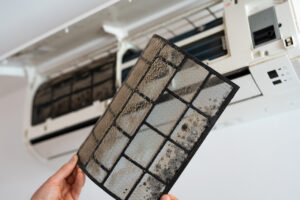 As you gear up to say farewell to summer and prepare for colder weather, are you prepared for the possible mold growth changing temperatures can bring?
As you gear up to say farewell to summer and prepare for colder weather, are you prepared for the possible mold growth changing temperatures can bring?
When we change seasons, the temperature swings can lead to perfect opportunities for mold to grow if we aren’t careful.
But don’t worry. That’s why I’m here.
I can help you spot what causes mold growth and a few changes you can make to keep your houses mold-free, as we transition from season to season..
Mold Growth and Changing Seasons
When the seasons change over, in most areas, it’s a gradual change. As we go from summer to fall, most areas still have unseasonably warm days, which are followed by cooler days (and nights).
The drops in temperature can lead to a buildup of condensation in your home. This can be very obvious in some cases—mirrors fogging up inside the house, windows and doors collecting condensation, etc. However, there are other areas you might not think to look.
Attics
Attics are one of the most popular places for mold to grow. The area is prone to large temperature swings throughout the year but the problem is exacerbated during the season changes.
Any small nooks and crannies near your roof are likely to collect moisture from the humidity and often, the insulation in attics provides a perfect snack for mold.
If you‘ve had any creatures finagle their way into your house, their front door might also be a hole in your attic. Be sure to check for any holes in the roof or any signs of critters living in the area.
Check to make sure you don’t have any signs of a leaky roof while you’re up there. Even if we can’t visually see the mold growing, it can be in the smallest cracks and crevices.
If you don’t see any mold growing, use your nose to see if you notice a musty odor. Mold has a very distinct smell and, combined with some of the other factors mentioned here, there’s a good chance you have mold growth.
Furnaces and Air Conditioning Units
Behind your furnace or heating unit is another prime spot for mold when the seasons change. As your furnace starts kicking on more often to heat up your home, it’s easy for condensation to accumulate and lead to mold growth.
Check around both the air conditioning and heating units as the weather begins to get colder if there’s a chance you’ll be using both.
Air Ducts
Poor ventilation is a leading cause of mold growth for a couple of reasons.
First, the lack of proper ventilation can lead to dust, dirt, and debris building up in your ducts. This will cause the air flow to be impeded and can lead to moisture accumulation.This has the added bonus of the dirt and debris providing a feeding source for the mold colonies.
Second, ideally, the ventilation in a house leads to the outdoors. This means that any humidity that builds up during a hot shower or bath is quickly whisked away to the outside. While rerouting your ventilation might not be a task you’re ready to take on just yet, if you’ve noticed a problem with mold in the past, this is definitely something you should look into sooner rather than later.
Contact Us
If you’ve already discovered mold growing in your home or facility, don’t panic. We can help and we’ll do it on a timeline that works with your schedule. Give us a call today and talk to one of our professionally certified employees to figure out what your next move is when it comes to mold.







